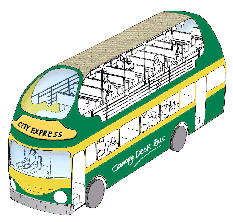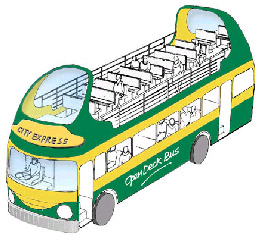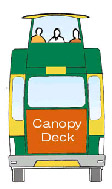|
Canopy
Deck Bus
This
innovative concept offers a pragmatic canopy deck bus design for
commuting in large cities becoming unmanageable due to poverty
driven growth. This design can also be adapted for tourism and inter
city travel.
|
Some
western countries have tourist buses with open deck seating on the
roof for tourists to enjoy sights during the pleasant tourist
season. In India, canopy deck city buses can be designed for regular
commuters for all seasons. Our common people are anyway commuting
every day on cycles, scooters, three-wheelers, tempos, trucks and
even on top of trains! A safe, all season canopy deck seating on
city buses can be sensitively designed to increase availability of
service on the same road space at a reduced capital cost, fuel
consumption and pollution.
Canopy
deck bus has a conductor seated behind a desk with an electronic
ticket dispensing machine, controlling entry to both floors, thus
obviating the need of two conductors. The floor level can have less
seats and more standing space depending upon the preference. The
upper deck will have only seated passengers.
|
 |
|
|
 |
Layout
of the upper deck provides 65 centimeters wide corridors on both
sides with 10 rows of three seats and two groups of 12 and 9 seats
at the front and back, totaling 51 seats. Taking advantage of the
seating below, the corridors have been depressed by 25 cms. Since
passengers will have to step up, as in cars, from the corridor to
get seated, the canopy height can be just 1.4 to 1.5 meters.
Its profile will thus be slim and low vis a vis double deck buses.
The
lower deck has been designed to provide for 45 seated and about 24
standing, a total of 69 passengers. The canopy deck bus can thus
have a total of 96 seated and 24 standing, a total of 120
passengers, out of whom 80 per cent will have seating comfort!
Present Delhi buses have 48 seated and 32 standing, a total of 80
passengers. Canopy deck buses will thus have one and a half times
capacity, reducing the requirement of buses to less than
two-third. With less buses on the road, bus turn round will be
faster, further reducing the requirement of buses.
|
|
Lower
level plan — 45 seated 24 standing |
 |
|
Upper
level plan — 51 seated |
|
A
colourful canopy can be provided over the upper deck. It can be
removed during sunny winter months. Transparent panels and doors
can, if needed, be provided in each cabin. If full protection is
desired, the outer body of the bus (with appropriate windows) can
be extended up to the canopy.
All
passengers will exit from the front door. The driver will, with
the help of the rear view mirror and/or electronic sensors,
restrict entry in the upper deck to vacant seats. Entry and exit
from the front door with the driver dispensing tickets is also
possible. The upper deck is likely to be more popular than the
lower one. |

|
City
buses are presently fitted with 110-125 horsepower diesel engines
that, considering they carry heavy truck loads, are adequate for
canopy deck buses. If desired, a turbo charger can be attached to
upgrade them to 140 horsepower for improving the pick up, without
increasing fuel consumption. Using any fuel such as CNG, fuel
consumption and polluting emissions will become two-third or less
of that at present. Canopy deck buses being 25 cms lower and
slimmer than conventional double deck buses will be more stable
and less prone to overturning. It
is with time that chassis manufacturers in India introduced low
bus chassis as in the West.
Canopy
deck buses offer a better visual and a more comfortable
environment than double deck buses, at less cost. They will be
attractive as commuter, school and tourist buses. They will save
on bus construction and fuel, reduce pollution and use less road
space. They will be highly cost effective in view of higher
earnings using less number of buses.
Presently, since
slow moving traffic occupies the left lane, buses often move on
the second lane leaving only the third lane for cars. This is
inefficient use of road space. In Curitiba, Brazil, the lanes
abutting the central verge have been made bus exclusive, leaving
the remaining lanes for other modes. IIT Delhi has recommended a
similar system for Delhi. It will mesh well with canopy deck
buses. q
| Design
Concept |
Design
Articulation |

|
| SK
Sharma, People First |
Sumit
Ghosh, Architect |
| (Design
right under process) |
|





